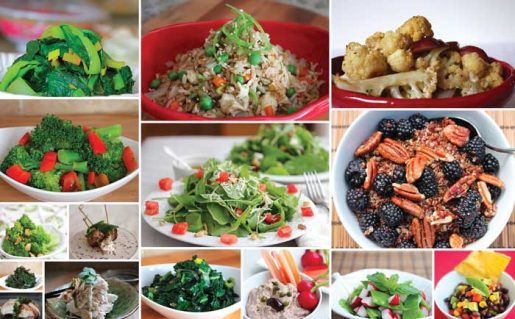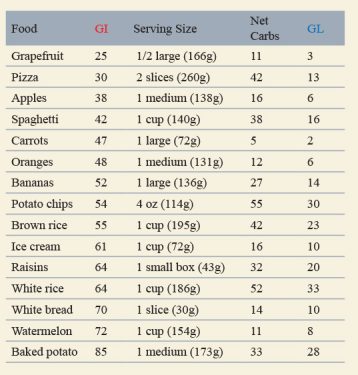Educational Series
The Science of Nutrition
By Mohammad Ahrar, PhD
Diets for Those with Diabetes
 Introduction
Introduction
According to the Centers for Disease Control and Prevention (CDC), 37.3 million people in the U.S. have diabetes, and 96 million Americans aged 18 years or older have prediabetes. Both types can be prevented or delayed with a healthy lifestyle and by eating healthy food. This article reviews basic information about what foods can help prevent or control prediabetes and type 2 diabetes.
Digestion and Absorption of Carbohydrates
Most of the foods you eat are broken down into simple molecules before being absorbed into the bloodstream. Normal diets contain nutrients such as carbohydrates (carbs), fats, proteins, vitamins, and minerals. Only proteins, fats, and carbohydrates can be used to produce energy. In humans, carbs are the main fuel source and provide quick energy for optimum metabolic reactions in the body cells.
When consumed, carbs (except fibers) are broken down into simple sugars, mainly glucose, which can easily be absorbed into the bloodstream and increase the blood glucose level rapidly. Brain cells depend on glucose to function. Proteins and fats can also be converted to sugar when carbs are not available in the diet, however, they usually do not raise blood sugar as quickly.
When blood sugar increases, it signals the pancreas to release insulin to help the blood sugar get into the body’s cells for use as energy. If insulin is not sufficiently produced, the blood sugar level stays up, which can result in serious health problems.
The Fate of Sugars in the Body
Like other nutrients (except fat molecules), absorbed glucose first enters the liver for metabolism. Some glucose can be stored in the liver as glycogen (a type of complex sugar), but most glucose is transported via blood circulation to all body cells for energy production and other metabolic reactions.
When ingested, all types of carbs (except fibers) can raise blood sugar. Fiber plays an important physiological role in the digestive system—it can regulate blood sugar levels by reducing the absorption rate of simple sugars. (The role of dietary fiber in the body was explained in Peyk #199).
Types of Carbohydrates in the Diet
Carbs come in different forms—they can be in the form of simple sugars or in more complex forms, such as cellulose and starch. The word sugar refers to simple carbohydrates such as glucose, fructose, and galactose (also known as monosaccharides). When two monosaccharides combine, they form a disaccharide. For example, glucose and fructose together make sucrose (table sugar). Starch is a complex carb (polysaccharide) made of many simple sugars, mainly glucose. Starch is abundant in potatoes, rice, wheat, corn, beans, and other grains.
Fibers are also polysaccharides and occur in all plants and plant-based foods. Cellulose is a type of insoluble fiber that cannot be digested in the human digestive system. Therefore, fiber adds no fuel or energy value to the diet but plays an important physiological role in the digestive system. Fiber can also regulate blood sugar levels by reducing the absorption rate of simple sugars. (See Peyk #199).

How a Dietary Regime Can Help Control Blood Sugar
Focus on the fiber contents in food. Any foods that are high in fiber content, such as lettuce, celery, spinach, broccoli, and most other vegetables, can prevent a drastic increase in blood sugar. Most seeds and whole grains and nuts contain different forms of fiber that can reduce or delay the release of sugars into the bloodstream. Pastries, cookies, sugary foods, and sugary soda drinks can increase blood sugar when consumed in a large amount.
Portion size matters. Those with diabetes don’t have to deprive themselves of carbs. Small amounts of carbs in the diet do not increase blood sugar as much as when carbs are consumed in a large portion. Besides, fat and fiber content in foods also delay the absorption of sugar.
The following information can help identify foods that have the greatest effect on elevating your blood sugar.
Glycemic Index (GI)
The Glycemic Index is a numerical index that ranks carbs based on the rate of how fast they increase blood sugar levels. The index uses a scale of 0 to 100, with higher values given to foods that cause the most rapid rise in blood sugar. Foods with a high glycemic index value raise the blood sugar level very quickly. (More information about the index can be found in Peyk #165.)
The downfall of the Glycemic Index is that it does not take into consideration how much the quantity of a food can elevate blood sugar rapidly. The American Diabetes Association also discounts the usefulness of the index in managing a diet regimen and blood glucose level.
For this reason, another index was developed in 1997 by researchers at the Harvard School of Public Health, the Glycemic Load, which incorporates both the amount and the type of carbs in a diet affecting the blood sugar level.
Glycemic Load (GL)
The concept of the Glycemic Load index is that the body’s glycemic response is dependent on both the type and the amount of carbohydrate consumed. Therefore, you can control your glycemic response by consuming low-GI value foods and/or by a smaller intake of carbs that have a high GI value. For example, the glycemic load value of eating two small slices of pizza is 13, which is higher than the recommended value. Eating one slice of pizza instead of two slices will bring the GL value lower than 10, which means a person can eat one slice of pizza without a sharp and sudden increase in blood glucose.
The table below summarizes the GI and the GL for some common foods which can help those with diabetes decide on their dietary regime.
Glycemic Index (GI) of 55 or below or Glycemic Load (GL) of 10 or below are considered low.

Based on the information in the table, eating one medium apple does not increase the blood sugar as much as eating one large banana. Consumption of two oranges in one setting can increase blood sugar more rapidly compared to eating one orange, which does not increase blood sugar as rapidly. You can also conclude that if you eat ½ of a slice of white bread it does not increase your blood sugar as much as if you ate the whole slice. In other words, the amount of carbs that you eat has a major influence on blood sugar levels.
Helpful Hints
Foods that are high in fiber content, such as lettuce, celery, spinach, broccoli, and most other vegetables can prevent a drastic increase in blood sugar.
Adding beans, lentils, and vegetables to plain rice, as we see in some Iranian meals, can delay the absorption of sugars and prevent the drastic rise in blood sugar.
Eating a whole fruit is preferable to fruit juice due to the fiber content in the fruit. Dried fruits have a high concentration of sugar and should be consumed in moderation.
Peeling an orange the way you peel an apple provides more fiber which can delay the absorption of glucose.
Consumption of brown rice is preferable to white rice due to more fiber content in brown rice.
A very ripe banana has both high GI value and high GL value and can elevate blood glucose rapidly. A small banana that is not quite ripe can be a better choice.
Foods that contain fat can slow down the digestion and absorption of glucose. That is why you see ice cream has lower GI and GL values than raisins do.
Nuts contain fiber and are dense in fat and can stay longer in the digestive system and delay the release of sugars into the bloodstream.
Portion size is probably the most important factor in controlling blood sugar levels. Diabetic people don’t have to deprive themselves of carbs. If one craves a cookie or a piece of pastry, eating half a cookie or half a slice of pastry does not increase blood sugar as fast as eating a whole cookie or a big portion of pastries. See the table above as a guide.
Summary
Prediabetes and type 2 diabetes can be prevented or delayed with a healthy lifestyle and eating healthy food. The Glycemic Index is a numerical index that ranks carbs based on the rate of how fast they increase blood sugar levels. Foods with a high glycemic index value raise the blood sugar level very quickly. The Glycemic Load index may be a more accurate measure because it states that the body’s glycemic response is dependent on the type and the amount of carb consumed. Many healthy foods—such as whole grains, legumes, and vegetables, and fruits such as whole apple, pear, grapefruit, and apricots—are naturally low on the glycemic index. Any foods that are high in fiber content can prevent a drastic increase in blood sugar. Portion size is an important factor. Small amounts of carbs in the diet do not increase blood sugar as much as when carbs are consumed in a large portion. Fats and fiber content in foods also delay the absorption of sugar.
References
• https://www.cdc.gov/diabetes/data/statistics-report/index.htmlCDC_AA_refVal%3Dhttps%253A%252F%252Fwww.cdc.gov%252Fdiabetes%252Fdata%252Fstatistics%252Fstatisticsreport.html&sa=D&source=docs&ust=1654898672241998&usg=AOvVaw2xOz6R6hCWiNfurDNka_b6
• http://www.hsph.harvard.edu/nutritionsource/2015/12/16/dr-david-ludwig-clears- up-carbohydrate-confusion/#more-12079
• Lutz, C. and Przytulski, K., Nutrition and Diet Therapy, 4th ed. (2006)
• http://nutritiondata.self.com/topics/glycemic-index#ixzz469BMu8ZD
• http://www.foodnutritiontable.com/nutritions/


















